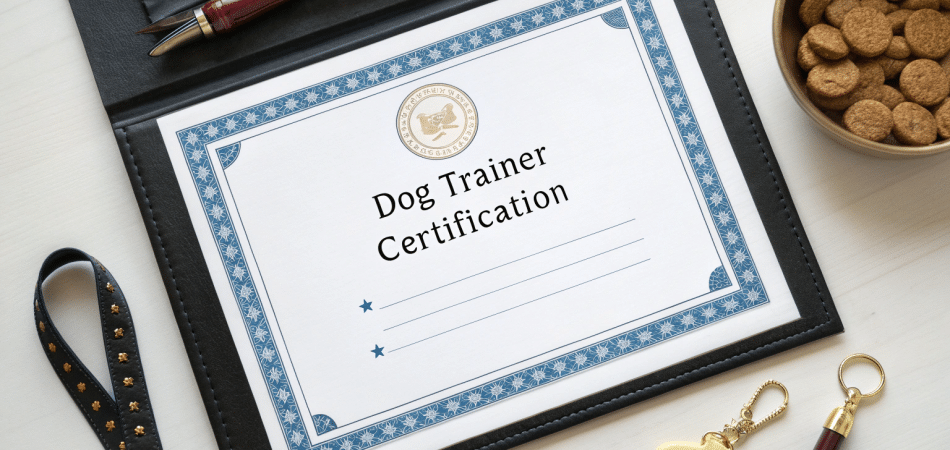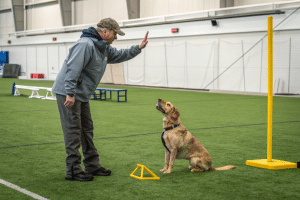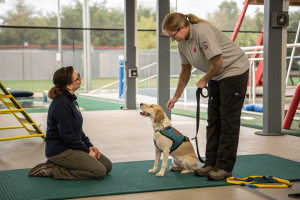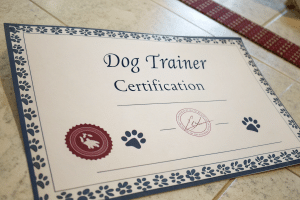






Whenever a prospective client visits or calls us, the conversations usually go a certain way. They ask about the dogs, the training, and how the process works. And at some point, a lot of these people question our expertise by asking, “What certifications do you have?”
And it’s alright. We get it.
When you’re considering investing in a protection dog, you want to be absolutely certain you’re working with people who know what they’re doing. Credentials feel like a straightforward way to measure that.
But what most people don’t realize: protection dog training certifications aren’t a one-size-fits-all system where you either have “the right” certification or you don’t.
It’s a wide, sometimes messy space — full of different organizations, different standards, and different meanings behind each piece of paper someone might hang on their wall.
And because we get asked about this so often, I think it’s time we break it down properly — not just so you understand what certifications we have, but so you know what certifications actually matter when you’re choosing a protection dog provider.
First and foremost…..
At its core, a dog trainer certification is a professional qualification you can earn to validate your skills and deepen your knowledge in the field.
It shows clients — and yourself — that you’ve put in the work to learn best practices, refine your techniques, and commit to a higher standard of training.
Now, here’s something important to understand:
You don’t legally need a certification to become a dog trainer. No universal body regulates the profession. Technically, anyone can call themselves a dog trainer — with or without formal education.
Still, serious professionals — especially in protection work, where the stakes are much higher — invest in certifications to stay sharp, ethical, and deliver high-quality, effective services.
Not all certifications are the same, though.
Some specialize in positive reinforcement. Others focus on working with aggression. Some simply cover general skills every professional should know, no matter the specialty.
Note:
Certifications are tools, not magic wands. They don’t guarantee greatness — but when earned intentionally, they elevate a trainer’s ability to deliver safe, high-quality results.
Here’s a quick breakdown of the main types you’ll come across:

However, the scope of these certifications is intentionally limited. They are designed for general pet training, not for preparing dogs to perform under duress, high distraction, or threat scenarios typical of protection work.
Without advanced layered training, basic obedience alone leaves significant gaps in readiness for protection or working dog fields.
These certifications focus on identifying, understanding, and reshaping complex canine behaviors, especially those related to fear, aggression, anxiety, and reactivity.
Behavioral modification credentials demonstrate a trainer’s ability to move beyond command-based instruction into altering the underlying emotional and cognitive states driving problematic behavior.
One respected program is Behavior Adjustment Training (BAT), developed by Grisha Stewart. BAT emphasizes empowering dogs to make socially appropriate choices through non-coercive setups.
Behavioral certifications also require trainers to understand differential reinforcement strategies, counter-conditioning protocols, and safety management — especially critical when working with high-drive protection dogs who may default to bite behavior under stress.
Equipment-specific certifications ensure trainers know not just how to use these tools, but when, why, and under what conditions their use is ethical and effective.
Most programs focus extensively on the correct use of modern training gear. These certifications require both theoretical understanding and practical demonstration under live supervision.
Proper certification teaches trainers:
Advanced trainers often customize their gear protocols based on each dog’s individual drive, nerve strength, and behavioral thresholds.

Here, certifications involve teaching dogs to perform life-changing tasks for individuals with disabilities. This includes mobility assistance, medical alert, psychiatric support, and even seizure response.
This kind of work demands reliability under high-pressure, high-distraction conditions — and a deep understanding of the human partner’s medical or psychological needs.
Assistance Dogs International (ADI) offers some of the most respected standards and guidelines for this field. While ADI does not directly offer certifications to individual trainers, it accredits programs that train and place service dogs.
Earning a legitimate certification in service dog training typically involves rigorous coursework covering:
According to Assistance Dogs International (ADI) and other industry benchmarks, it typically takes 18 to 24 months to prepare a service dog to professional standards fully.
Most general dog trainer certifications — the ones focused on obedience, behavior modification, or positive reinforcement — are valuable, no question.
They show that the trainer understands how dogs think, how they learn, and how to communicate with them fairly and effectively.
But protection work? That’s a whole different ballgame.
Training a protection dog is more about shaping a dog’s instincts, control, and judgment under real-world pressure.
You’re not just looking for obedience — you’re looking for stability, courage, and discernment.
The dog must know when to act, how to act, and when to hold back. And that level of precision requires specialized certifications and titles more than standard ones.
Things like:
Each of these certifications signals something slightly different about the dog’s (and the trainer’s) capabilities — and it’s important to know what you’re looking for based on your own needs.
The name on a certification matters just as much as the paper it’s printed on.
There are dozens of organizations offering dog training certifications, but not all carry the same weight.
Some are highly respected across the industry. Others? Honestly, they’re a little more of “pay a fee, get a certificate” operations.
Here’s a quick guide to the respected ones:
IGP is one of the oldest and most respected dog sport certifications. It’s no walk in the park, either — dogs are rigorously tested across three phases: tracking, obedience, and protection. An IGP title shows a dog is balanced, stable, and capable under pressure.
The IACP promotes balanced training methods that use positive reinforcement and fair, humane corrections to shape reliable behavior.
IACP was created to raise the standard of professionalism within the dog training and behavior industry, offering a path for trainers who value compassion and effectiveness.
Trainers certified through the IACP are required to demonstrate competency across a wide range of methodologies, including:
IACP certification isn’t a one-time achievement. Trainers must complete ongoing education credits to maintain their credentials.
The PSA was founded in 2001 to test and showcase real-world protection abilities in dogs — not just controlled, rehearsed scenarios, but unpredictable, dynamic challenges that mirror actual threats.
Unlike traditional sport certifications that often prioritize pattern-based exercises, PSA focuses on a dog’s ability to think, adapt, and perform under pressure when a situation goes sideways.
The sport is divided into two main phases:
Earning a PSA title isn’t easy. The testing standards are deliberately unforgiving, exposing any weaknesses in stability, drive control, environmental resilience, and decision-making under stress.
For trainers working in executive protection, security K9, or serious personal protection, PSA certification is one of the clearest markers of real-world working ability.
While primarily geared toward police K9s, NAPWDA certifications have serious value for civilian protection work, too. Dogs (and handlers) are tested in real-world deployment skills like suspect apprehension, handler protection, and obedience under duress.
If a trainer has NAPWDA experience, you can trust they understand how dogs need to perform when it actually matters — not just in the safety of a training field.
This organization focuses heavily on humane training methods, high ethical standards, and ongoing professional development.
Trainers certified through NAPDT are committed to ethical, science-based practices — and to constantly improving their craft.
AWDA certifies working dogs and handlers across various operational fields, including protection, scent detection, tracking, and police K9 deployments.
Founded to set a consistent, high-level standard for working dogs in real-world environments, AWDA is known for its rigorous testing protocols and no-compromise approach to certification.
Passing rates for AWDA certifications are intentionally low — only about 30–40% of teams pass on their first attempt. This strictness ensures that only genuinely capable dogs and handlers carry an AWDA title.
Unlike the big national organizations, these certifications are usually offered by private companies.
Some of them are excellent. Some… not so much. Since there’s no universal standard here, it’s critical to ask more questions:
Because trust me: there’s a massive difference between a dog that completed a serious three-phase protection trial… and a dog that got a participation ribbon after a weekend seminar.

If someone says their dogs are “certified protection dogs” but can’t tell you who certified them, how they were evaluated, or what the certification involved… that’s a problem.
Titles like CGC (Canine Good Citizen) are great for manners and obedience — but they mean absolutely nothing in personal protection. If a provider keeps pointing to obedience titles as proof of protection ability, be skeptical.
Book knowledge is one thing. Real-world experience — training dogs to protect in unpredictable environments — is something else entirely. A reputable trainer should be able to tell you about the scenarios they prepare their dogs for, not just rattle off theory.
Dogs aren’t robots. A good trainer will tell you what their dogs are trained to do, their limitations, and how the transition to your home will be handled. If someone promises a “perfect” dog with no adjustment period or ongoing training needs? Run.
You can have a wall full of certifications and still not be very good at training protection dogs.
On the flip side, there are trainers with minimal formal certifications who are absolute masters of their craft — because they’ve put in the reps, handled countless dogs, solved real-world problems, and earned a reputation the hard way.
So if you’re serious about finding the right trainer or training provider, here’s what you should be looking at:
How many protection dogs have they successfully trained? How many handlers have they coached? What’s their track record in real protection scenarios?
Past clients will tell you everything you need to know. Look for consistent feedback about professionalism, results, and ongoing support after placement.
A great trainer should have no problem showing you their work — live. Watch how their dogs respond under command. Watch how they handle the dog. Watch how stable, confident, and controlled the dog looks in different situations.
Training isn’t just about teaching a dog to bite on cue. It’s about understanding canine behavior — knowing when a dog is truly ready for work, when it’s stressed, when it needs more training, and how to set it up for success long-term.
Protection training should never rely on fear, abuse, or excessive force. Real professionals understand how to develop a dog’s confidence, stability, and natural protective instincts — not just brute-force obedience.
By itself, certification is an incomplete education. I know that’s going to ruffle some feathers — but it’s the truth. Here’s why:
Most organizations that offer a certificate focus almost exclusively on “positive training” methods. The coursework usually covers a history of dog training, some heavy reading on operant conditioning and canine behavior, and a limited amount of actual hands-on work.
Rarely — if ever — does it include serious study of alternative approaches. Even more rarely does it tackle the realities of aggression or protection work in the real world.
At Vanguard Protection Dogs, we believe qualifications come from real success — not a string of letters after your name.
In the old days, dog training was a family trade. Knowledge would be passed down from generation to generation — often through years of gritty, hands-on experience, not textbooks and certificates.
Interestingly, that’s still true today. But dog training, unlike other skilled trades, has never had a formalized apprenticeship system. Most serious trainers today either apprentice unofficially with a mentor or immerse themselves in active collaboration with other trainers (often both).
And the best ones? They don’t limit themselves to curated course materials — they study everything. Every philosophy. Every method. Every research paper — not just the ones that fit a convenient narrative.
There’s no easy way to quantify real experience — because true expertise is built over thousands of hours, hundreds of dogs, and a relentless commitment to learning, adapting, and improving.
And if you’re wondering about our certifications?
Vit Singh — our founder and head trainer — has a boatload of them. All from highly respected institutions around the world. PLUS, our team includes instructors with serious backgrounds — from elite European paramilitary units to top-tier North American training programs.
But those papers aren’t what makes Vanguard different.
The dogs are our qualifications. Dogs like this. And this. And this.